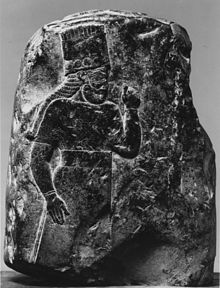Marduk-nādin-aḫḫē
Marduk-nādin-aḫḫē was 1099-1082 BC. King of Babylon ( Isin II period ).
A boundary stone ( kudurru ) with a royal deed of land was discovered in 1788 by the French traveler Antoine Michaux south of Baghdad and given to the French National Library . He became known as Caillou Michaux . It was one of the first cuneiform documents to reach the West. Its first two registers show symbols of gods, including the horned dragon of Marduk . Below is a slightly offset two-line inscription.
literature
- Kathryn E. Slanski: Classification, historiography and monumental authority: The Babylonian entitlement Narûs (kudurrus). In: Journal of Cuneiform Studies. Volume 52, 2000, pp. 95-114.
Individual evidence
- ↑ Kathryn E. Slanski: Classification, historiography and monumental authority: The Babylonian entitlement Narus (kudurrus). In: Journal of Cuneiform Studies. Volume 52, 2000, p. 95
| predecessor | Office | successor |
|---|---|---|
| Enlil-nādin-apli |
King of Babylonia 1099-1082 BC Chr. |
Marduk-šāpik-zēri |
| personal data | |
|---|---|
| SURNAME | Marduk-nādin-aḫḫē |
| ALTERNATIVE NAMES | Marduk-nadin-ahhe |
| BRIEF DESCRIPTION | King of Babylon |
| DATE OF BIRTH | before 1099 BC Chr. |
| DATE OF DEATH | after 1082 BC Chr. |
